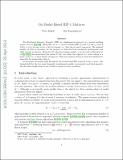On Model-Based RIP-1 Matrices
Author(s)
Indyk, Piotr; Razenshteyn, Ilya
DownloadIndyk_On model.pdf (222.3Kb)
OPEN_ACCESS_POLICY
Open Access Policy
Creative Commons Attribution-Noncommercial-Share Alike
Terms of use
Metadata
Show full item recordAbstract
The Restricted Isometry Property (RIP) is a fundamental property of a matrix enabling sparse recovery [5]. Informally, an m ×n matrix satisfies RIP of order k in the ℓ p norm if ∥ Ax ∥ p ≈ ∥ x ∥ p for any vector x that is k-sparse, i.e., that has at most k non-zeros. The minimal number of rows m necessary for the property to hold has been extensively investigated, and tight bounds are known. Motivated by signal processing models, a recent work of Baraniuk et al [3] has generalized this notion to the case where the support of x must belong to a given model, i.e., a given family of supports. This more general notion is much less understood, especially for norms other than ℓ2.
In this paper we present tight bounds for the model-based RIP property in the ℓ1 norm. Our bounds hold for the two most frequently investigated models: tree-sparsity and block-sparsity. We also show implications of our results to sparse recovery problems.
Date issued
2013Department
Massachusetts Institute of Technology. Computer Science and Artificial Intelligence Laboratory; Massachusetts Institute of Technology. Department of Electrical Engineering and Computer ScienceJournal
Automata, Languages, and Programming
Publisher
Springer-Verlag Berlin Heidelberg
Citation
Indyk, Piotr, and Ilya Razenshteyn. “On Model-Based RIP-1 Matrices.” Automata, Languages, and Programming (Lecture Notes in Computer Science; volume 7965) Springer Berlin Heidelberg. (2013): 564–575.
Version: Author's final manuscript
ISBN
978-3-642-39205-4
978-3-642-39206-1
ISSN
0302-9743
1611-3349